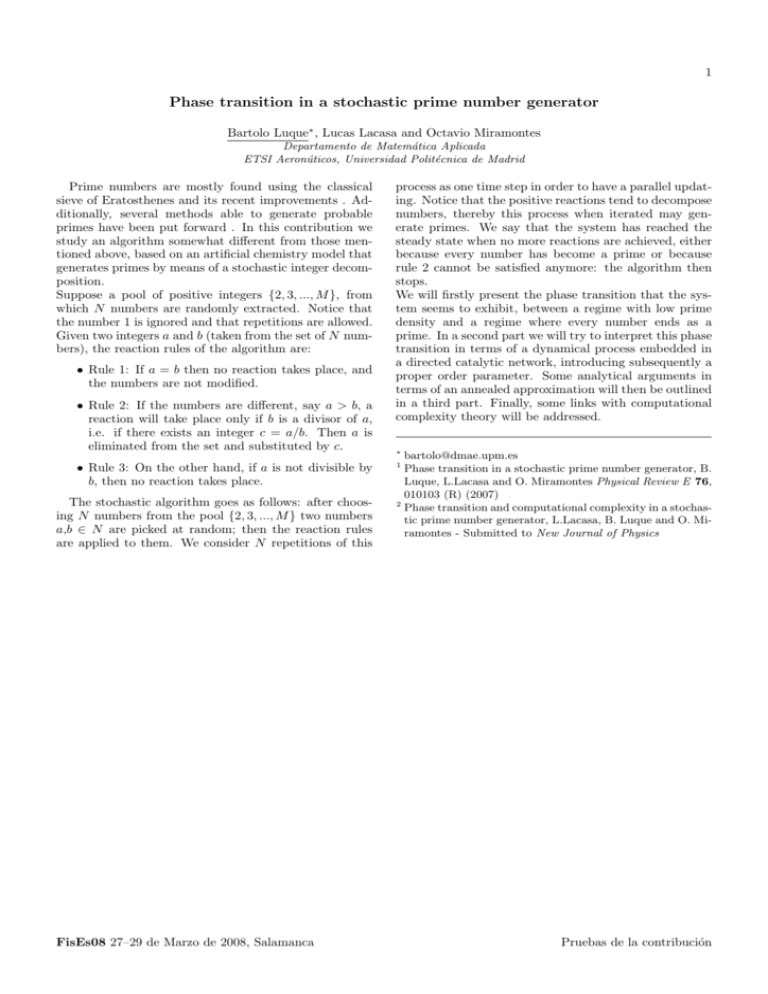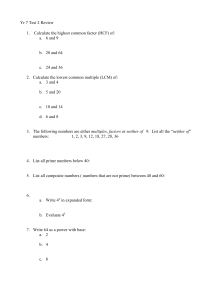Phase transition in a stochastic prime number generator
advertisement

1
Phase transition in a stochastic prime number generator
Bartolo Luque∗ , Lucas Lacasa and Octavio Miramontes
Departamento de Matemática Aplicada
ETSI Aeronúticos, Universidad Politécnica de Madrid
Prime numbers are mostly found using the classical
sieve of Eratosthenes and its recent improvements . Additionally, several methods able to generate probable
primes have been put forward . In this contribution we
study an algorithm somewhat different from those mentioned above, based on an artificial chemistry model that
generates primes by means of a stochastic integer decomposition.
Suppose a pool of positive integers {2, 3, ..., M }, from
which N numbers are randomly extracted. Notice that
the number 1 is ignored and that repetitions are allowed.
Given two integers a and b (taken from the set of N numbers), the reaction rules of the algorithm are:
• Rule 1: If a = b then no reaction takes place, and
the numbers are not modified.
• Rule 2: If the numbers are different, say a > b, a
reaction will take place only if b is a divisor of a,
i.e. if there exists an integer c = a/b. Then a is
eliminated from the set and substituted by c.
• Rule 3: On the other hand, if a is not divisible by
b, then no reaction takes place.
The stochastic algorithm goes as follows: after choosing N numbers from the pool {2, 3, ..., M } two numbers
a,b ∈ N are picked at random; then the reaction rules
are applied to them. We consider N repetitions of this
FisEs08 27–29 de Marzo de 2008, Salamanca
process as one time step in order to have a parallel updating. Notice that the positive reactions tend to decompose
numbers, thereby this process when iterated may generate primes. We say that the system has reached the
steady state when no more reactions are achieved, either
because every number has become a prime or because
rule 2 cannot be satisfied anymore: the algorithm then
stops.
We will firstly present the phase transition that the system seems to exhibit, between a regime with low prime
density and a regime where every number ends as a
prime. In a second part we will try to interpret this phase
transition in terms of a dynamical process embedded in
a directed catalytic network, introducing subsequently a
proper order parameter. Some analytical arguments in
terms of an annealed approximation will then be outlined
in a third part. Finally, some links with computational
complexity theory will be addressed.
∗
bartolo@dmae.upm.es
Phase transition in a stochastic prime number generator, B.
Luque, L.Lacasa and O. Miramontes Physical Review E 76,
010103 (R) (2007)
2
Phase transition and computational complexity in a stochastic prime number generator, L.Lacasa, B. Luque and O. Miramontes - Submitted to New Journal of Physics
1
Pruebas de la contribución








